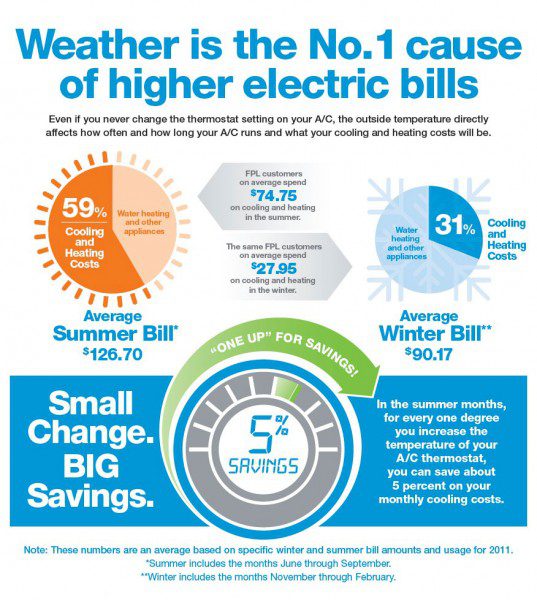 Summer is really heating up! As the temperatures start to rise, customers sometimes notice their electric bill rise as well. Fact is, the two are linked, but there are simple things you can do to keep your bill low during the summer months.
Summer is really heating up! As the temperatures start to rise, customers sometimes notice their electric bill rise as well. Fact is, the two are linked, but there are simple things you can do to keep your bill low during the summer months.
Weather is the main cause of higher electric bills
As outside temperatures go up, your air conditioner works longer to get the inside temperature down to a comfortable temperature, causing an increase in energy costs. In the summer time, air conditioning can account for half or more of electric bills, with outside temperatures directly affecting how often and how long systems must run to cool homes.
How to keep your summer electric bill low
FPL customers have the lowest electric bill out of all 55 utilities in the state, but it’s nice to know that you can make your bill even lower by using some energy efficiency tricks to counter the effects of warmer weather. For example, did you know that for every one degree higher you set your indoor temperature, you can save about 5 percent on your monthly cooling costs?
Check out these additional tips to help keep out excess light and heat:
Shade window and glass doors that face east and west, as they are the most prone to letting unwanted heat into your home. Consider shading those areas with mature size plants (with proper distance away from power lines), awnings and window coverings.
Weather stripping is an inexpensive solution to help reduce the amount of air that enters or escapes your home through doors and windows. Types of weather stripping include V-shaped vinyl, adhesive-backed foam, spring metal and door sweep.
Caulking is another way to reduce unwanted airflow. It is only worthwhile when done as part of another project. Use silicone or siliconized-acrylic caulk because they have the longest life span, work well on most surfaces and will maintain their elasticity.
Adding insulation to your home can help reduce heating and cooling costs. Homes built after 1982 are required to have R-19 insulation, which is the level we recommend. However, if your home was built before 1982, you may benefit from adding insulation.
For more tips and programs to help manage energy costs this summer, visit www.FPL.com/toolkit <http://www.fpl.com/toolkit> . There you will find the top 10 energy-saving tips, an interactive house with room-by-room tips and information on savings when purchasing a new air conditioner. Additionally, you can get a personalized energy-savings plan by completing an Online Home Energy Survey at www.FPL.com/ohes <http://www.fpl.com/ohes>.







Comments are closed.